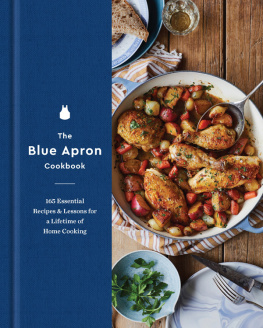

Copyright 2022 by Rockridge Press, Oakland, California
No part of this publication may be reproduced, stored in a retrieval system, or transmitted in any form or by any means, electronic, mechanical, photocopying, recording, scanning, or otherwise, except as permitted under Sections 107 or 108 of the 1976 United States Copyright Act, without the prior written permission of the Publisher. Requests to the Publisher for permission should be addressed to the Permissions Department, Rockridge Press, 1955 Broadway, Suite 400, Oakland, CA 94612.
Limit of Liability/Disclaimer of Warranty: The Publisher and the author make no representations or warranties with respect to the accuracy or completeness of the contents of this work and specifically disclaim all warranties, including without limitation warranties of fitness for a particular purpose. No warranty may be created or extended by sales or promotional materials. The advice and strategies contained herein may not be suitable for every situation. This work is sold with the understanding that the Publisher is not engaged in rendering medical, legal, or other professional advice or services. If professional assistance is required, the services of a competent professional person should be sought. Neither the Publisher nor the author shall be liable for damages arising herefrom. The fact that an individual, organization, or website is referred to in this work as a citation and/or potential source of further information does not mean that the author or the Publisher endorses the information the individual, organization, or website may provide or recommendations they/it may make. Further, readers should be aware that websites listed in this work may have changed or disappeared between when this work was written and when it is read.
For general information on our other products and services or to obtain technical support, please contact our Customer Care Department within the United States at (866) 744-2665, or outside the United States at (510) 253-0500.
Rockridge Press publishes its books in a variety of electronic and print formats. Some content that appears in print may not be available in electronic books, and vice versa.
TRADEMARKS: Rockridge Press and the Rockridge Press logo are trademarks or registered trademarks of Callisto Media Inc. and/or its affiliates, in the United States and other countries, and may not be used without written permission. All other trademarks are the property of their respective owners. Rockridge Press is not associated with any product or vendor mentioned in this book.
Interior and Designer: Jane Archer
Art Producer: Tom Hood
Editor: Jacinta OHalloran
Production Editor: Caroline Flanagan
Production Manager: Martin Worthington
Cover photography and food styling Hlne Dujardin, 2021. Interior photography Kate Sears, 2020, p..
Paperback ISBN: 978-1-63807-914-9 | eBook ISBN: 978-1-63807-549-3
R0
Contents
CHAPTER 1:
Gluten-Free Cake Basics
CHAPTER 2:
Snacking Cakes
CHAPTER 3:
Layer Cakes
CHAPTER 4:
Bundt and Angel Food Cakes
CHAPTER 5:
Cupcakes and Mini Cakes
I worked my way through college in the 1980s and early 1990s in the bustling kitchens of fine dining restaurants. The passion and creativity of the job seduced me, and I ended up devoting almost 25 years to a career as a professional chef. I could make any dish, but I baked all kinds of cakes and desserts for fun and eventually started a successful cake design business. My portfolio included birthday cakes that looked like waterfalls, stunning cupcake towers topped with white chocolate roses, and a wedding cake covered in 4,000 handcrafted sugar paste apple blossoms for a Boston Bruins hockey player. My cakes were gorgeous and magical, but also exceptionally deliciouswhich is more important.
Requests for gluten-free cakes were infrequent in the early years, but when someone asked me for one, it was with an apology to me and a sad exclamation that they knew the cake wouldnt be as good as a normal one. That sounded like a challenge to me, so I tested and tweaked my recipes until they worked beautifully. Gluten-free baked items dont have to be a compromise; they can stand alone as moist, tender, and deliciousconfections you can be proud to serve even the most critical guest. Some cakes are even indistinguishable from their wheat-based counterparts.
You will benefit from my decades of trial-and-error cake baking experiences in the recipe chapters. Ive included some of my favorites, like on effective substitutions for this diet. Dont be afraid to experiment with the cakes and frostings to suit your palate. If chocolate is your jam and a recipe uses peanut butter icing, swap it out. Also, keep in mind that recipes sometimes dont work out exactly right for various reasons; just try it again another day and use the imperfect layers or cupcakes for a scrumptious trifle. Most of all, have fun. You are making cakes, and what could be better than that?

Gluten-free baking has changed over the last few decades; ingredients are now widely available, and many people follow this diet for health and personal reasons. Because of this surge in interest, gluten-free cakeswhile not exactly like the traditional versionare spectacular in taste, texture, and appearance. If you are new to baking gluten-free cakes, this chapter will be an invaluable resource for when you try your hand at your own recipes. If you are a veteran baker, you still might learn new information or a few tricks.
The Role of Gluten in Cake Making
Gluten is a protein found in cereal grains, which creates the structure of baked products, usually bread. When milled, the structure of the grain seed is destroyed, but its parts remain in the resulting flour, including the enzymes that cause chemical reactions responsible for seed germination. When water is mixed with flour, these enzymes become active again, and the starch granulewrapped protein strandsglutenin and gliadinunwind and re-form into gluten. When making a cake, an extensive gluten network is not encouraged; the beating is to blend the ingredients and add air to the batter. So, gluten is not a crucial consideration, but it does play a role.
Glutens effect on texture: Lower-protein flours such as cake flour create softer crumb cakes; higher-protein flours produce a tough cake. Overmixing also produces dense, tough cakes, because gluten can stretch and form stronger networks. This is why most cake recipes say mix until just combined when stirring in the dry ingredients.
Glutens effect on rise: In bread and yeasted products, as the dough is mixed, the protein chains multiply and become longer, creating a network that holds its shape and expands. This network traps gases, creating the coveted rise; a weak network means bread that falls flat. Gluten enhances the rise in cakes because it provides the structure; you just dont want to overdo it.
Glutens effect on moisture: Gluten sucks up and retains water, so baked goods do not dry out in a hot oven or after cutting.











